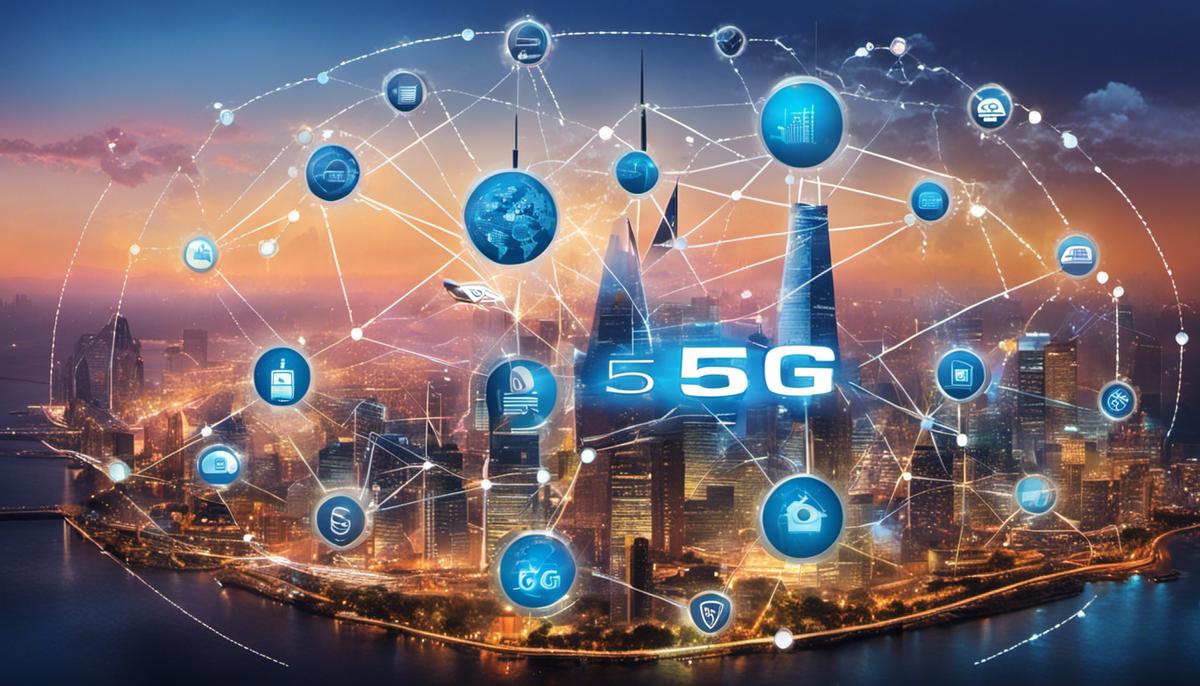As the world strides towards the era of hyper-connectivity, 5G network security—the successor of 4G cellular technology—promises unprecedented speed, reliability, and capacities. Unlocking enhanced machine communication capabilities it is poised to be a linchpin in the unfoldment of the Internet of Things (IoT), autonomous vehicles, and smart cities. However, in the wake of its prodigious potential, there are critical security considerations. Hence, we delve deep into the makeup of 5G networks, underlining what sets them apart from their predecessors and probe into the security challenges that have arisen due to these very advancements. Furthermore, this discourse highlights how cutting-edge technology comes to the rescue, bridging the security gaps, and showcases the trends that are expected to shape the 5G network security landscape in the coming years.
Understanding 5G
Unmasking the Unique Features of 5G Network Technology
As we hover on the precipice of the fifth generation of mobile network technology, aptly named 5G, anticipation continues to swell in the spheres of technology and communication. Promising to revolutionize our digital, technological landscape, 5G boasts distinct features that set it apart from its predecessors. Let’s unravel the unique attributes that frame this formidable wave in the digital revolution.
Unprecedented Speed and Latency
Right off the bat, 5G technology is vouched for its blazing-fast speeds. A substantial leap from the 4G LTE network, 5G is projected to offer 10 to 100 times faster connections. Content influx that would take minutes to download on a 4G LTE network could take mere seconds with 5G. What’s more, 5G significantly slashes latency, bringing it down to almost real-time levels. This translates to seamless, almost instantaneous data transfer that will not only enhance user experience but also revolutionize fields like autonomous driving, precision robotics, and telemedicine.
Network Slicing
A unique feature of 5G technology is network slicing. This is the ability to slice a single physical network into multiple virtual networks tailored for specific uses or business models. This feature isn’t just about data speed or capacity but making the network more flexible and adaptable to support a wide range of applications and services.
Enhanced Capacity
5G technology is architectured to significantly improve network capacity, promising a sea change in the data congestion faced during heavy usage situations. It paves the way for more devices to connect and communicate simultaneously, which makes it a linchpin for unlocking the full potential of IoT (Internet of Things).
Robust Broadband Connectivity
Take a minute to imagine seamless broadband-equivalent network coverage regardless of location — urban jungles, remote landscapes, high-speed vehicles; you name it. The focal vision for 5G is to offer flawless broadband connectivity and hand over previously unimaginable power to mobile users.
Massive IoT Densification
5G technology paves the way for expanded IoT use, allowing millions of devices per square mile to connect, enabling a host of advanced applications beyond our imagination. From connected vehicles, smart cities, and telehealth to Industry 4.0, the densification potential of 5G circumvents issues of overloading and underutilization presented by previous generations.
In conclusion, the rise of 5G represents a quantum leap in network technology, touting superior speed, ultra-low latency, enhanced capacity, network slicing, and unprecedented IoT densification. As this advanced network rolls out in the coming years, we are set to witness technology’s compelling transition to an era of seamless connectivity and enhanced productivity. Because that’s what 5G is all about –enabling us to live smarter, work more efficiently, and unleash the full potential of the digital world.

Security Challenges
Unveiling the Security Threats Encircling 5G Network Technology
5G network technology surges ahead with game-changing benefits. As the torch Lightbearer revolutionizes connectivity, its golden promises of high-speed communication, network slicing, and a massive boost in IoT densification are undeniably attractive. However, with great power comes great responsibility. In the case of 5G, this revolves around confronting and mitigating the looming security threats it faces.
Firstly, the nationwide implementation of 5G networks exposes them to an increased risk of cyberattacks. With 5G’s tendency to connect more devices through its massive IoT densification, the attack surface broadens significantly, opening doors to various potential security breaches.
A second threat lies in the physical security of 5G infrastructure. The multitude of smaller, lightweight antennas needed for a full 5G network increases the risk of physical damages, thefts, and manipulations. These physical security challenges may impact network stability and reliability if not given due consideration.
Moreover, the advanced software-defined networking (SDN) and network functions virtualization (NFV) central to 5G expose it to new vulnerabilities. In this sphere, the threat comes from the inability to sequester applications and data physically. This grants unfettered access, overshadowing the promises of seamless connectivity and robust broadband functionality that 5G brings.
One particularly disconcerting actor is the deployment of the supply chain. As 5G components are obtained from global vendors, potential threats could lurk behind any piece of technology, creating backdoors through malicious hardware or software. Given the intricate and global nature of these supply chains, ascertaining the total absence of malicious implants is practically impossible.
The network slicing feature, while revolutionary, introduces its own set of challenges. If a specific slice gets compromised, cybersecurity risks can significantly escalate. Data from that slice could be misappropriated or, even worse, used as a gateway to infiltrate and compromise other slices.
Finally, there is the threat of service disruption. In this interconnected IoT-driven world where numerous services rely heavily on the network, attacks resulting in the disruption of these 5G-dependent services could have potentially catastrophic—and costly—consequences.
In the face of these risks, it’s clear the 5G revolution isn’t without its potential pitfalls. There’s an urgent need for cybersecurity measures to evolve in pace with this blisteringly fast technology to ensure the bright promises of tomorrow don’t turn into the cybersecurity nightmares of today. The sooner these security issues are addressed and mitigated, the sooner 5G can revolutionize the world as we know it without veiling in fears of security breaches.

Security Solutions for 5G
The advent of 5G networks introduces various security concerns that need immediate attention and resolution. Here are some leading-edge solutions that proactively address these vulnerabilities.
Artificial Intelligence (AI) is a powerful tool for combatting the increased risk of cyberattacks. AI security systems are capable of learning and adapting to patterns of network behavior, allowing for the identification and mitigation of threats in real-time. Plus, AI can automate the process of threat detection, which significantly reduces the likelihood of cyberattacks evading notice.
To tackle physical security challenges, leading technology companies have turned to edge computing. With edge computing, data is processed closer to its source, reducing the need for transmission across long distances. This technology not only mitigates the risk of physical security breaches but also results in faster data processing speeds, further enhancing the function of 5G networks.
Addressing vulnerabilities in software-defined networking (SDN) and network functions virtualization (NFV) starts with the implementation of rigorous testing and validation regimes. The focus should be on ‘security by design’, whereby security is integrated into every step of the development and deployment process. The use of sandboxes to isolate potentially risky processes or applications from the rest of the network forms an additional layer of protection.
As for supply chain threats, blockchain technology offers a promising solution. Blockchain provides a level of transparency and verification that has the potential to reduce cyber attacks originating from the supply chain drastically. With the help of their decentralized and immutable nature, blockchains enable secure tracking of all transactions and interactions, making it difficult for unauthorized changes to go unnoticed.
The issue of network slicing, where a single network is divided into multiple unique, virtual networks, can be mitigated through a systematic design and management approach. Leveraging network function virtualization, network slices can be isolated and monitored individually, which can prevent a security breach in one slice from affecting the others.
Last but not least, to deter service disruption, fail-safe mechanisms and redundancies need to be integrated into 5G networks. This would ensure that even if an element of the network fails, traffic can be rerouted, and the overall integrity of the network can be maintained.
In conclusion, while the challenges are substantial, there are robust solutions available to address the security threats posed by 5G networks. By prioritizing security measures and harnessing cutting-edge technology, the future of 5G can become as promising as the speed it offers. It’s always important to remember that no technology is perfect at birth, but with due diligence and evolvement, its potential can be fully realized.

Future Trends and Predictions
A Future of 5G: Trends and Predictions Concerning 5G Security
In the epoch of elevated connectivity, the rapid evolution of 5G technology marks the true realization of the Internet of Things (IoT) revolution. This unprecedented enabler for extraordinary data rates, ultra-low latency, and reliable connections is not without its own set of significant challenges, particularly in the area of security. Let’s examine the anticipated trends and predictions concerning 5G security that technology enthusiasts will be watching in the near future.
Expect greater scrutiny in legislative and regulatory environments for 5G security, given the deep-rooted vulnerabilities it presents. Governments worldwide are committing billions of dollars to research, development, and implementation of strategies like Zero trust – a drastic departure from the conventional network perimeter model – designed to counterbalance 5G’s inherently vast attack surface.
AI and Machine Learning (ML) are already on the verge of being commonplace, with leading organizations strategizing for strengthened AI-based intrusion detection systems. Moving forward, real-time AI and ML systems will become integral to safeguarding the 5G secure landscape. Experts postulate an upsurge in ML-adaptable malware exploiting lax security protocols, mirroring serious efforts in AI-powered cyber defense.
Ever heard of Quantum Cryptography? Touted as the next big thing, it’s designed to secure against ubiquitous cryptographic attacks and is increasingly deemed a necessity with 5G’s exposure. While current encryption keys can be cracked given powerful enough technology, keys encrypted using quantum cryptography are believed to be uncrackable even with future tech developments.
Next, Hyperautomation – a tech term that’s already buzzing – would bind 5G security and operational efficiencies together. The utilization of a mix of technologies like AI, ML, and Robotic Process Automation (RPA), revolves around the notion of automating anything that can be automated, ultimately playing a pivotal role in protecting 5G from security risks.
Intriguingly, Confidential Computing is sparking interest as a new approach to cybersecurity. It isolates sensitive data in a protected CPU enclave during processing, eliminating possible data exposure to other parts of the system. This technique could become critical in safeguarding information passed through 5G networks.
Resistance is futile – the next evolution of networks is here. Embrace it. As enlightening as these advancements are, they underline the principle that security will always be a prime concern whenever new technology emerges. It’s up to every technology enthusiast, innovator, and leader to commit to securing our connected tomorrow. Buckle up for an exhilarating journey to the intelligent, autonomous world spun around 5G – a reality that lies just around the corner.
Technological evolution is an unending journey, and as we chart the territories of the future, the vexing complexities only grow. Yet, it is through these perplexities that we usher in groundbreaking solutions. 5G network, with its allure of speed, capacity, and machine communication, promises a revolution, but not without its share of security challenges. Amidst this conundrum, cutting-edge technologies such as artificial intelligence, sophisticated encryption, and edge computing provide the much-needed bulwark. As we gather knowledge of how the future might unfold, with the burgeoning role of AI for threat detection and advancements in encryption techniques, it is essential to understand that the pursuit of security is continuous, but we are better prepared than ever to handle the threats, ensuring that the dawn of the 5G era is secure and benefits all.

